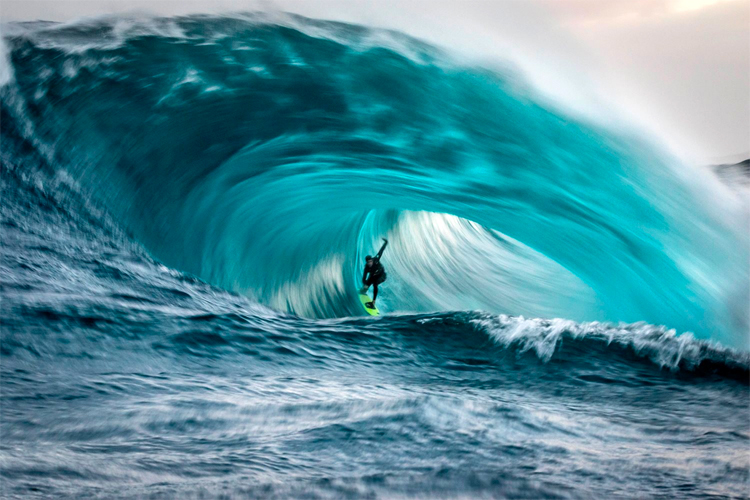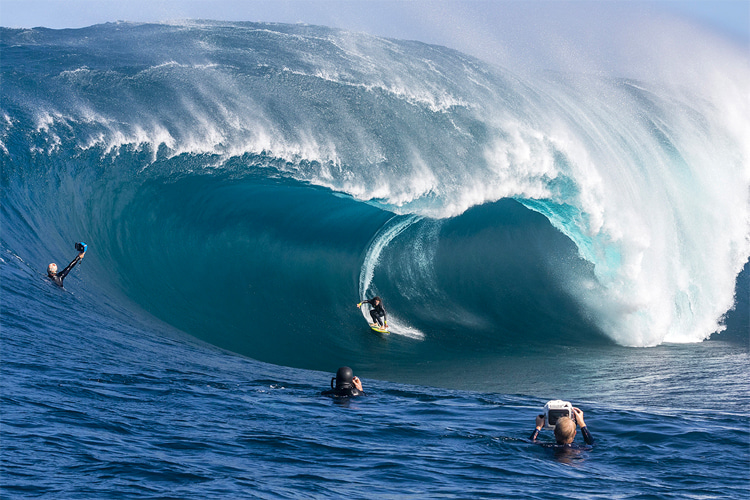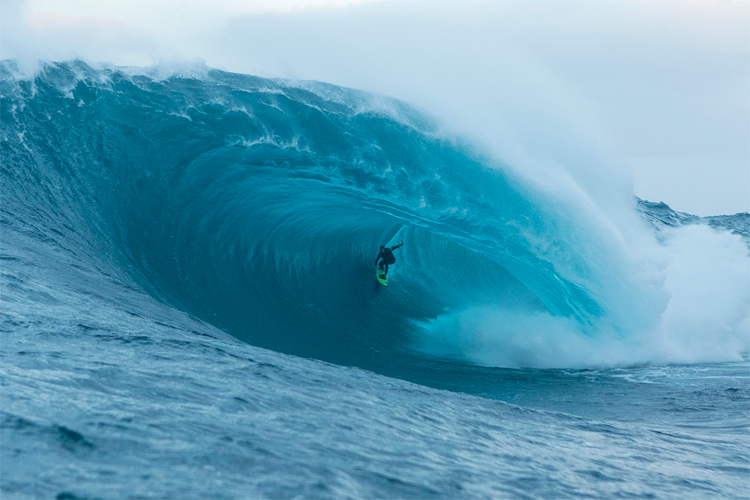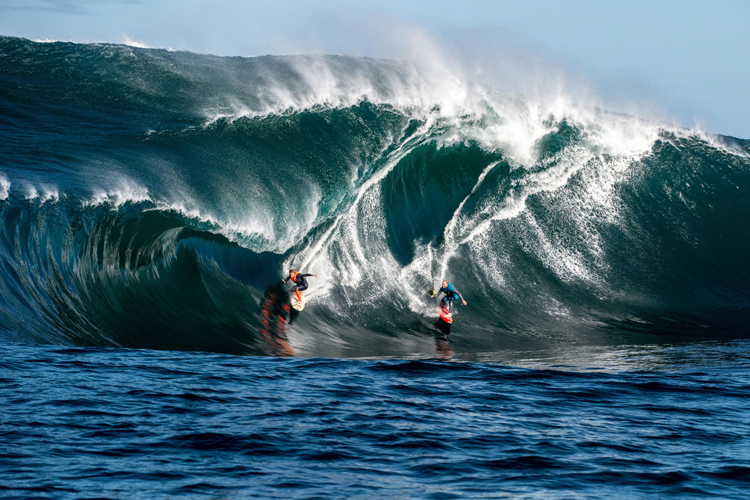The Right is a mammoth reef break located one mile (1.6 kilometers) off the coast of Walpole in Western Australia. It produces a wave that is only comparable to the anxiety levels it raises.
It is big, dangerous, fast, unpredictable, and brutally heavy. There's nothing mellow and obvious here.
Welcome to The Right, one of the most challenging waves on the planet and one of Australia's top 3 slabs, alongside Shipstern Bluff and Cape Fear/Ours.
As Ryan Hipwood once said, "You never know what you're dropping into. When you're on the wave, and it shuts down, the ocean swallows you."
In 2012, the Australian almost died surfing the infamous offshore surf break, but he wasn't the only one who suffered its ferocity.
Several professional swell hunters were injured and required hospitalization after being towed into the right-hand liquid beast and hit by the truck-sized water box.
WA's legendary open ocean surf break is no place for average surfers. It's a do-or-die playground with random outcomes.
The Right is a slab that produces a thick and square wave that can hold surfers underwater for a long time and break bones in a split second.
The surf spot was first ridden on September 2, 2007, by a group of hardcore bodyboarders, including Brad Hughes, Chad Jackson, Dean Harrington, and Sean Virtue.
Let's take an in-depth look at this terrifying freak of Nature born in Southwest Australia.

The Mechanics of The Right
How and when does the Western Australian big wave come to life?
The Right is an offshore surf break exposed to the Southern Ocean, its raging storms, ultra-fast winds, and powerful swells coming from all angles.
This outstanding natural phenomenon is fueled by the Albany Canyon, a submarine canyon located 25-55 miles (40-90 kilometers) south of the southwest Australian coastline.
When deep ocean wave trains hit the 435-mile (700 kilometers) long network of underwater ravines that extend from Cape Leeuwin to Esperance, swells gain additional energy.
Therefore, when these groups of traveling ripples reach The Right, waves rise to 26 feet (8 meters).
Another variable to consider is the dry, barnacle-encrusted reef. Without it, this wave wouldn't be what it is.
Interestingly, it first breaks on a shallow shelf and then falls into a deeper water section that can hold surfers inside the barrel for a few seconds.
But this is randomness territory where two consecutive waves behave radically differently.
The WA beast rarely roars to life.
Nevertheless, the best conditions for watching The Right in full glory are with W, SW, S, and SE groundswells and light N, NW, and NE winds.
The ride at The Right is usually short.
But, according to professional big wave surfers who survived it, the experience is scary and feels like you're having a heart attack.

A Russian Roulette
As we've seen above, The Right is totally unpredictable.
What appears as a perfect wave can suddenly morph into a massive close-out that will keep its prey inside a thick and fast-breaking wall of water.
Tow-in, inflatable vests, and jet ski support are mandatory, but even that might not be enough to avoid injuries and life-threatening events.
Professional surfers with years of experience riding big and challenging waves have had their fair share of close calls at the notorious WA surf spot.
Wipeouts here are always spectacular, eye-catching, and breathtaking. Fortunately, to date, no one lost their life at The Right.
The reward of surviving this wave of consequence is also extreme and intense - like surviving a war or an earthquake.
Mark Mathews, Bradley Norris, Dean Morrison, Laurie Towner, Zac Haynes, Russell Bierke, Taj Burrow, Ross Clark-Jones, Jake Stone, Mick Corbett, and those who have tamed The Right describe it as a euphoric ride on a living rollercoaster.
The raw power of The Right and its mutating curtain of water make it one of the scariest waves in the world.
"The wave doesn't even have a lip; it has the whole ocean behind it," as someone once wrote.
It resembles a colossal slab of ocean folding over that will never make you want to go left. And as an extra, you get shark-infested waters.
Whenever surfers see the light at the end of the barrel, they get slingshot like a human cannonball. The clips speak for themselves.

The Right Women
The reef break's violent reputation is also attracting an increasing number of women into the life-or-death arena.
In June 2020, Laura Macaulay became the first female surfer to take on The Right.
"Sometimes, on those waves out there, I can't remember what happened. It's a funny feeling. It's sort of really exciting but also hard to recall sometimes," Macaulay revealed.
"Growing up in Ghost Town was so amazing. Surfers have always been attracted to riding those large waves. That's part of the adrenaline rush."
After Macaulay's adrenaline rush debut at The Right, it was time for professional competitive surfer Laura Enever.
"Surfing at The Right, I just couldn't get rid of the negative thoughts," explained Enever.
"It was playing on my mind that everything was going to go wrong, and I just couldn't get that out of my head."
The Australian surfer says it requires intensive mental preparation to be ready for these types of challenges.
"Even if I was just sitting out there waiting for the wave, I couldn't stop thinking about sharks, getting injured, or the worst-case scenario."
"I had to just really get out of the water - like, 'I just have to stop, and I have to go sit here for a second and get control of myself again.'"
"I sat there for 30 minutes to get control of myself before I wanted to try again, but I got over, which was a good thing."
The Ultimate Paddling Frontier?
The Right is the only big wave in the world that has never been paddled.
Excluding a few bodyboarders like Ryan Hardy, no surfer has ever attempted to use arm power to get into a wave at the infamous WA reef break.
Professional surfers and local chargers are divided as to whether it will be possible to paddle into a wave with these characteristics.
Some say it might be paddled to some degree, for instance, smaller waves that peak up a bit further inside.
But when the waves hit 15 feet plus, paddling could be nearly impossible because surfers would need to backdoor the peak of a wave that has no back and no precise take-off zone.
However, there's a small group of daredevils who think it's possible to throw themselves over the ledge.
How?
One theory is that goofy footers may paddle into The Right easier than regular footers.
Why?
Because they feel that grabbing the rail is easier and more stable than performing a bottom turn and trying not to catch a rail.
The example given is Nathan Florence's iconic take-off at Teahupoo in 2015. Could you do it on your forehand?
Alternatively, another approach could be taking off behind the peak and backdooring it at full speed. Any takers?
